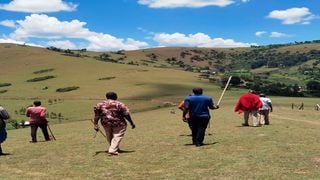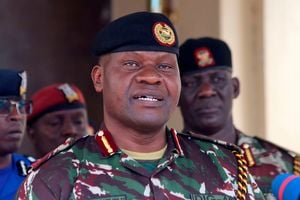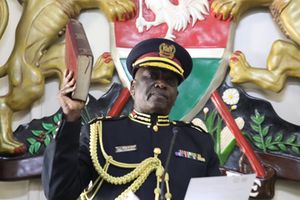
Residents go up the Ol Donyo Mayana mountain in Poroko village in Kilgoris, Narok County.
News
Premium
Ol Donyo Mayana: The mountain of love, peace and harmony
When one gets to Ol Donyo Mayana, which is Maasai for “Mt Love”, a scene in Ngugi wa Thiong’o’s seminal novel The River Between replays in one’s mind.
Ol Donyo Mayana towers above Poroko, a remote village in Kilgoris, Narok County. Surrounding it are Kisii, Migori, Narok counties as well as neighbouring Tanzania. The area reincarnates scenes in The River Between with an uncanny exactitudes.
Ngugi's book opens with a riveting passage: “The two ridges lay side by side. One was Kameno, the other was Makuyu. Between them was a valley. It was called the valley of life.”
It goes on: “Behind Kameno and Makuyu were many more valleys and ridges, lying without any discernible plan. They were like many sleeping lions that never woke. A river flowed through the valley of life... The river was called Honia, which meant cure, or bring back to life.”
“When you stood in the valley the two ridges ceased to be sleeping lions.”
“They became antagonists. You can tell this not by anything tangible but by the way they faced each other, like two rivals ready to come to blows in a life and death struggle for the leadership of the isolated region”.
This introduction sets the stage for a story set somewhere in Central region in colonial-era Kenya.
It is the mountain’s gentle topology that gave it the moniker “Nakuyana”, that loosely translates to “a cool and soft thing”. While Ngugi's text comes to mind, it does so in contrasting fashion.
The most observable feature is that Ol Donyo Mayana has two valleys, each sloping from its foot and extending towards the opposite direction but with no river flowing between them.
Another striking difference is that here, on the outskirts of Kilgoris town, are three ridges, not two as was the case with Kameno and Makuyu.
Human settlements hug the foot of the mountain, which is a far cry from Ngugi's description of a near life and death struggle for the soul of an isolated region.
Retired Chief Joseph Ole Suya, 59, is a resident here. He says Ol Donyo Mayana has been at the centre of peace efforts, not just in Kenya, but in the entire East Africa region.
“Standing here, you will see all the sides of Kenya. There is Maasai Mara (Narok). That side is Kisii and Migori in Nyanza. And that there is Tanzania while beyond those hills is Nairobi,” said Mr Ole Suya. In 2003, he recalled, surveyors from Kenya, Tanzania and Uganda climbed Ol Donyo Mayana and pinned a metal bar at a spot on the mountain.
That was at a time when there were disputes between the three countries over the ownership of Migingo Island in Lake Victoria.
Locals believe that Ol Donyo Mayana is the reference point for surveyors regarding the boundary of the three neighbouring countries.
Mr Ole Suya said the physical feature has played a part in peace efforts between Kenya, Tanzania and Uganda and even the three neighbouring counties of Migori, Kisii and Narok.
The mountain also has religious significance as some pilgrims visit it to worship and rest.
Various choir groups have also used the site to shoot their music videos.
Love birds often take advantage of its serenity to have picnics and outings, Mr Meshack Lemiso Kapario told the Nation.
“Up here, there is a high sense of peace, love and tranquillity,” Mr Lemiso said.
For the Maasai community, the ridge has white stones that are of great cultural significance.
“This forested part of the ridge is 'jandoni' where circumcised boys stay for two months to heal.”
“The white powder from the stone keeps the initiates fresh as bathing is discouraged during the entire healing period," said Mr Kapario.
He called on the area MP, Mr Julius Sunkuli, and President William Ruto to lead efforts to popularise Ol Donyo Mayana as a tourist attraction and a cultural site.





